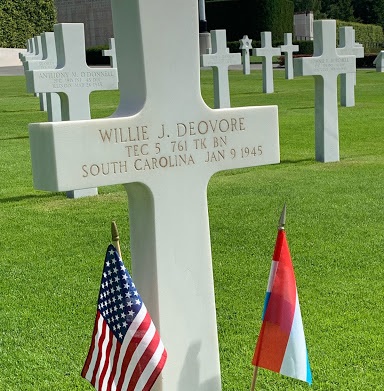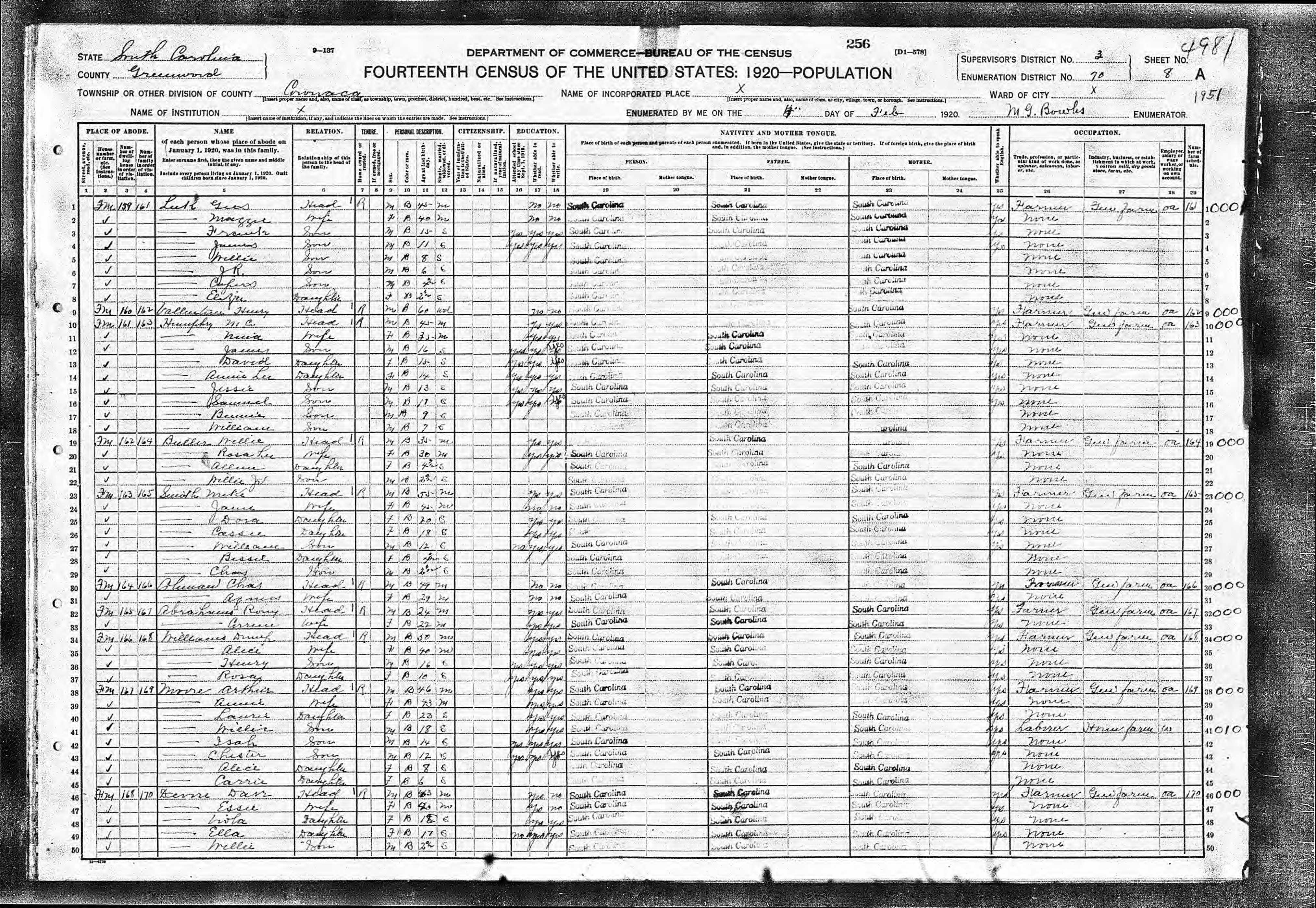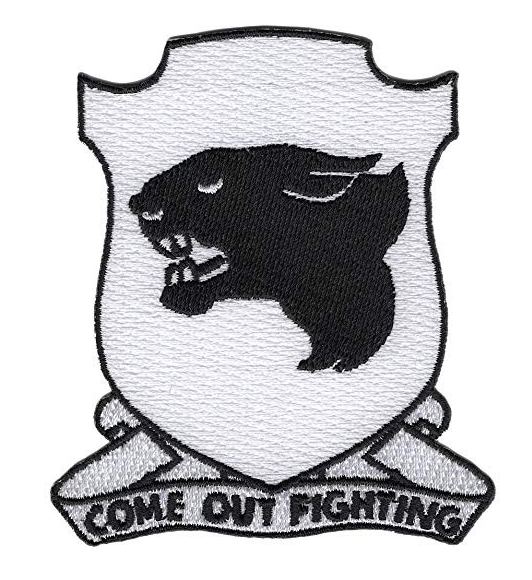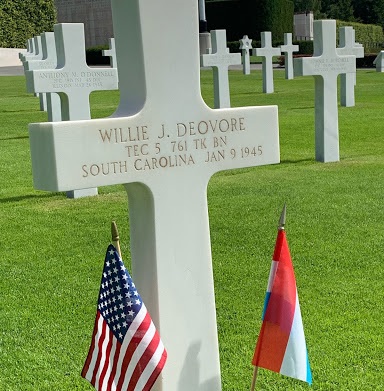Technician Fifth Grade William J. Devore

- Unit: 761st Tank Battalion
- Service Number: 34120536
- Date of Birth: April 20, 1919
- Entered the Military: January 19, 1942
- Date of Death: January 9, 1945
- Hometown: Greenwood, South Carolina
- Place of Death: Bastogne, Belgium
- Award(s): Purple Heart
- Cemetery: Plot C, Row 6, Grave 9. Luxembourg American Cemetery
DeKalb County Public Schools
2018-2019
Early Life
Willie J. Devore was born to Dave and Eloise (Essie) Devore in Coronaca, a small town in the low-lying Piedmont region of western South Carolina. Greenwood County, where Coronaca is located, was one of the state’s leading cotton-manufacturing areas in the early twentieth century, thanks to its three mills. However, mill jobs were not available to Greenwood’s African-Americans.
Dave Devore, like almost all the other African American men in the area, worked as a farmer. Essie, a homemaker, had three children to look after: Willie and his much older sisters, Viola and Ella. Willie, known to some friends as “Little Bit,” was small in stature, but had an outsized personality. Sociable and fun-loving, he made friends and cracked jokes easily.
Willie Devore, whose formal education ended in grammar school, spent time as a shoe shiner in a barbershop and as a cook. The area where he grew up, scarred by Jim Crow discrimination, offered limited opportunities for African Americans. The 1895 South Carolina Constitution effectively stripped the state’s African Americans of voting rights, and the economic landscape was bleak. In 1920, only two of Coronoca’s 190 African American families owned homes. The others, like the Devores, rented. By comparison, 45 of the town’s 60 white families owned homes, with the men working in a broader range of occupations.

Military Experience
Training
The United States leapt into World War II after President Franklin D. Roosevelt’s fiery address to Congress the day following the Japanese attack on Pearl Harbor. About six weeks later, on January 19, 1942, Devore enlisted at Fort Jackson, South Carolina, about 100 miles from home. He was sent to basic training at Fort Knox, Kentucky. Racial discrimination was a constant presence there. According to authors Kareem Abdul-Jabbar and Anthony Walton, Devore and the other African American soldiers were almost never permitted to fire live ammunition during their 13-week training, whereas the white soldiers at Knox regularly trained with live rounds.
Meanwhile, continued pressure from various sources – black leaders such as Walter White and A. Philip Randolph as well as white leaders such as General Lesley J. McNair and First Lady Eleanor Roosevelt – led the government to expand opportunities for African American soldiers. This advocacy helped increase the number of African American soldiers in the Army from 3,640 in 1939 to nearly 500,000 by the end of 1942.
The 758th Tank Battalion (Light) was the first all-black battalion of the World War II era, having been formed in May 1941. Devore joined the second such unit, the 761st Tank Battalion, which was activated on April 1, 1942, at Camp Claiborne, Louisiana. At Claiborne, the soldiers’ training centered on the operation and maintenance of the M5 Stuart tank.
Based on their skills and character, the soldiers were designated for specific roles within the tank – gunner, assistant gunner, and commander. Devore was chosen to be a driver. His friend William McBurney begged Devore to let him drive sometimes, as the soldiers of Charlie Company enjoyed racing the tanks back from the training range.
On September 14, the battalion was transferred to Camp Hood, Texas, its final stop before shipping out. They upgraded equipment from the M5 to the more powerful M4 Sherman tank, a nimble vehicle that would be used primarily for infantry support. By the time they arrived at Fort Hood, Devore had become well-known for the frequent letters he received from female friends back in South Carolina. He would entertain his new buddies by reading them parts of the letters.
With the passing of each month, hundreds of thousands of American soldiers shipped out across the ocean, Atlantic or Pacific, to fight. The 761st Tank Battalion, however, went nowhere. This reality was a source of frustration for many of the soldiers, already anxious to jump into the action and do their part to defeat the enemy.
There was a silver lining to the long wait. The 761st Tank Battalion was more prepared than most when its number was called. According to public affairs specialist Hank Heusinkveld of the U.S. Army Corps of Engineers, the battalion had been told by “higher commanders, including the 2nd Army’s Lt. Gen. Ben Lear, that it had a superior record and that much was expected of it.”
Shipping out
On June 9, 1944, the 761st Tank Battalion received its orders to prepare to deploy overseas. It did not surprise the soldiers that they were headed for France. D-Day, the beginning of the Allied invasion of Nazi-occupied France, had taken place three days earlier. Huge numbers of troops and massive support were needed to push the Germans off the heavily defended French coast. After a few days of enjoying the nightlife in New York City, the 761st Tank Battalion was ready to embark in early August. Private E.G. McConnell recalled, as they steamed out of New York Harbor and passed the Statue of Liberty aboard the H.M.S. Esperance Bay, that Devore said he was not coming back. While deployed, Devore spoke freely of his sense of dread about the realities of warfare.
After a short stay in England, the battalion arrived in France in October 10, 1944. Two weeks later, they had advanced inland to Nicolas de Port and linked up with the 26th Infantry Division, part of General George S. Patton Jr.’s Third Army. At full strength of 676 enlisted men, 30 African American officers and six white officers, the 761st Tank Battalion was poised to become the first African American armored unit to see combat.
The men adopted a motto from the strategy of African American boxing champion Joe Louis, who said he would “come out fighting” in a 1938 title bout against German heavyweight Max Schmeling. Later, they would become known as the Black Panthers in reference to a patch of the animal they wore on their uniforms.
First Combat Action
According to his memoir War As I Knew It, Patton had doubts about the capabilities of African American soldiers to handle the quick thinking and decision-making necessary in an armored unit. The men of the 761st Tank Battalion had no way of knowing that. They were deeply inspired when he visited them on October 28, stood atop an armored car and announced, “I would never have asked for you if you weren’t good… I don’t care what color you are, as long as you go up there and kill those Kraut [expletive]… Everyone has their eyes on you and is expecting great things from you. Don’t let them down and [expletive], don’t let me down!”
Over 183 consecutive days of combat, the Panthers followed Patton’s directive. Five months after D-Day, the Allied Powers had retaken most of France. Next, they needed to force a German retreat out of northeast France as well as neighboring Belgium and Luxembourg. This is where the 761st Tank Battalion was needed most.
On November 8, 1944, the battalion, attached to the 26th Infantry Division, fought south of Château-Salins and through Moncourt Woods. Within a week, it was onto Morville and Metz, France, where they faced fierce resistance from the German First Army. By November 22, the fighting in Metz ceased, thanks in no small part to the 761st Tank Battalion.
Morville had been particularly rough for a unit new to combat. The names of the 15 soldiers killed in two days were posted outside a commanding officers’ tent. “If it goes on like this,” Devore said, “ain’t none of us going back home.”
Despite the losses, the 761st Tank Battalion passed every test. Major General Manton J. Eddy, commanding officer of the Third Army’s XII Corps, singled out the Black Panthers with high praise, “I consider the 761st Tank Battalion to have entered combat with such conspicuous courage and success as to warrant special commendation,” Eddy wrote, praising the “speed,” “gallantry” and “great bravery” that led Major General Willard S. Paul to express “extreme gratification” to the unit.
The enemy noticed, too. A captured German soldier remarked, “Never before have I seen such bravery except once, and that was on the Russian front.”
The Bulge
Moving even closer to the France-Germany border, the 761st Tank Battalion broke through the Maginot Line. For six weeks, the unit supported the 87th Infantry Division and 17th Airborne Division, at the Battle of the Bulge. The Panthers engaged in a tremendous counteroffensive against what became the last German attack on the Western Front.
Despite the German advantages related to terrain and visibility, the battalion pushed the enemy eastward through the densely forested Ardennes region. The soldiers had their hands full with the 13th Panzer Division’s elite Begleit Brigade, originally formed as a protection force for Adolf Hitler.
The Panthers pushed into Belgium, where the next challenge was to reach Tillet. They accomplished this objective by pushing the Germans back 25 miles from December 30, 1944, to January 4, 1945. The Panthers faced machine-gun nests, tanks, anti-tank guns, and subzero temperatures, but pressed on, close to cutting off a key German supply corridor known as the Marche-Bastogne Road.
On the night of January 9, the Germans retreated eastward out of Tillet. The 87th Infantry Division, alongside the 761st Tank Battalion, had scored yet another victory – but not without the ultimate sacrifice.
Under heavy fire, Devore’s tank had been hit by what his comrades believed was an 88-mm shell. The Sherman’s tracks had been blown off and its wheels were spinning feebly in the snow. As the driver, Devore was powerless. William McBurney, Leonard Smith, and Teddy Windsor burst out of the tank, spilling frantically onto the frozen ground and scrambling away. According to authors Abdul-Jabbar and Walton, a second shell hit the tank. Devore did not stand a chance.
The Black Panthers continued eastward, further than nearly every other American unit. They broke through the Siegfried Line. They were one of the first units to meet the Russian Army in Austria. They participated in four major campaigns, fought in six countries, and proved many doubters wrong.


_page-0001.jpg)
Eulogy
On January 14, 1945, five days after he was killed, Devore was buried in the U.S. military cemetery in Grand-Failly, in northeast France, near the border France shares with Luxembourg and Belgium. His remains were interred in Grand-Failly for four years and then, upon his mother’s request, were transported approximately 75 kilometers to Luxembourg American Cemetery. On March 22. 1949, Devore’s remains were re-interred in Luxembourg American Cemetery, his final resting place.
For decades near Devore’s hometown, there stood a war memorial with separate listings for fallen white and black soldiers from the Greenwood, South Carolina, area. But in May 2018, in a move unprecedented in South Carolina, a ruling by a circuit court judge cleared the way for the memorial to be replaced with one that includes no references to race.



Reflection
Bibliography
“761st Tank Battalion.” 761st Tank Battalion and Allied Veterans Association. Updated January 30, 2014. Accessed December 9, 2018. www.761st.com.
Abdul-Jabbar, Kareem and Anthony Walton. Brothers in Arms: The Epic Story of the 761st Tank Battalion, WWII’s Forgotten Heroes. New York: Broadway Books, 2004.
Armored Battalion; World War II Operations Reports, Records of the Adjutant General’s Office, 1917-, Record Group 407 (Boxes 13577-13578); National Archives at College Park, College Park, MD.
“Battle of the Bulge Interactive Map.” Library of Congress. Accessed March 31, 2019. www.loc.gov/collections/world-war-ii-maps-military-situation-maps-from-1944-to-1945/articles-and-essays/the-battle-of-the-bulge/interactive-timeline/.
Buckley, Gail. American Patriots: The Story of Blacks in the Military from the Revolution to Desert Storm. New York: Random House, 2001.
Heusinkveld, Hank. “The 761st Tank Battalion: Fighting the Enemy, Beating Stereotypes.” U.S. Army Public Affairs Center. Updated February 9, 2007. Accessed February 18, 2019. www.army.mil/article/1792/the_761st_tank_battalion_fighting_the_enemy_beating_stereotypes
Lewis, J.D. “Greenwood County, South Carolina.” Carolana. Updated 2019. Accessed March 30, 2019. www.carolana.com/SC/Counties/greenwood_county_sc.html.
Patton, George S. War as I Knew It. New York: Houghton Mifflin Harcourt, 1947.
Sasser, Charles W. Patton’s Panthers: The African-American 761st Tank Battalion in World War II. New York: Pocket Books, 2004.
South Carolina, Greenwood County. 1920 U.S. Census. Digital images. ancestry.com.
South Carolina, Greenwood County. 1930 U.S. Census. Digital images. ancestry.com.
South Carolina, Greenwood County. 1940 U.S. Census. Digital images. ancestry.com.
U.S. Army Organization History Files; U.S. Army Operational, Tactical, and Support Org., Record Group 338 (Box 12); National Archives at College Park, College Park, MD.
Willie J. Devore, Individual Deceased Personnel File, Department of the Army.
Wilson, Dale E. “The Army’s Segregated Tank Battalions in World War II.” Military History No. 32 (Fall 1994): 14-17.
This profile was researched and created with the Understanding Sacrifice program, sponsored by the American Battle Monuments Commission.

